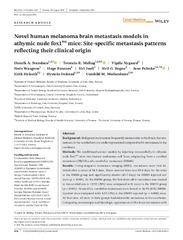Novel human melanoma brain metastasis models in athymic nude fox1nu mice: Site-specific metastasis patterns reflecting their clinical origin
Permanent link
https://hdl.handle.net/10037/24114Date
2021-10-06Type
Journal articleTidsskriftartikkel
Peer reviewed
Author
Svendsen, Henrik Aasrum; Meling, Torstein Ragnar; Nygaard, Vigdis; Waagene, Stein; Russnes, Hege Elisabeth Giercksky; Juell, Siri; Rogne, Siril Gudmundson; Pahnke, Jens; Helseth, Eirik; Fodstad, Øystein; Mælandsmo, Gunhild MariAbstract
Methods: We established animal models by injecting intracardially in athymic nude fox1nu mice two human melanoma cell lines, originating from a cerebral metastasis (HM19) and a cerebellar metastasis (HM86).
Results: Using magnetic resonance imaging (MRI), metastases were first detected after a mean of 34.5 days. Mean survival time was 59.6 days for the mice in the HM86 group and significantly shorter (43.7 days) for HM19-injected animals (p < 0.001). In the HM86 group, the first detectable metastasis was located in the cerebellum in 15/55 (29%) mice compared with none in the HM19 group (p < 0.001). At sacrifice, cerebellar metastases were found in 34/55 (63%) HM86- injected mice compared with 1/53 (2%) in the HM19-injected (p < 0.001) mice. At that time, all mice in both groups had detectable metastases in the cerebrum. Comparing macroscopic and histologic appearances of the brain metastases with their clinical counterparts, the cell line-based tumors had kept their original morphologic characteristics.
Conclusions: The present work demonstrates that human brain-metastatic melanoma cells injected intracardially in mice had retained inherent characteristics also in reproducing interaction with subtle microenvironmental brain tissue compartment-specific features. The models offer new possibilities for investigating tumor- and host-associated factors involved in determining tissue specificity of brain metastasis.


 English
English norsk
norsk